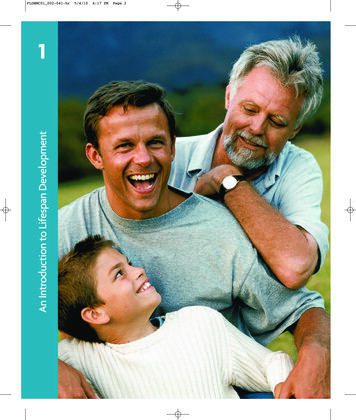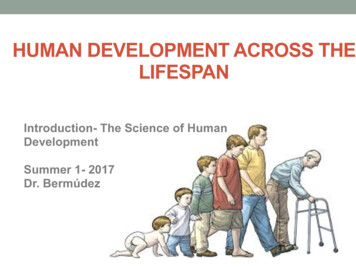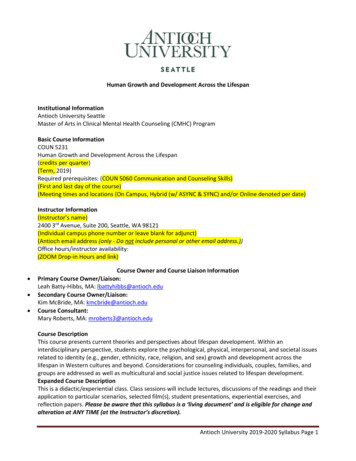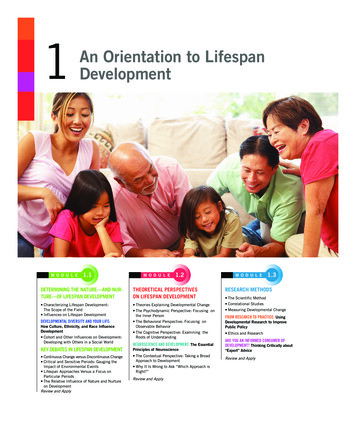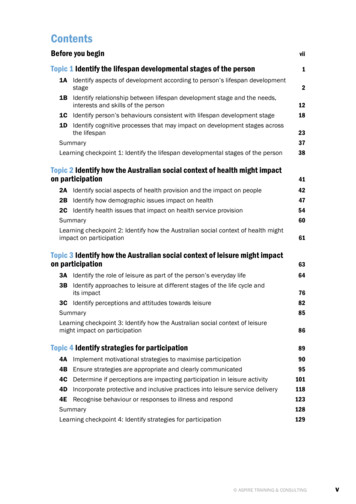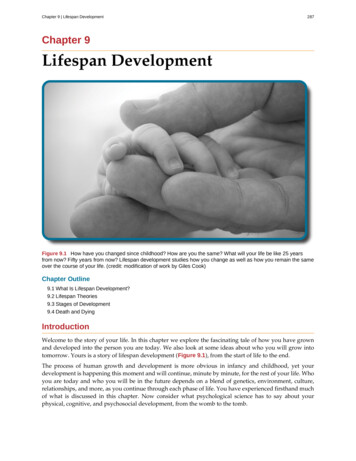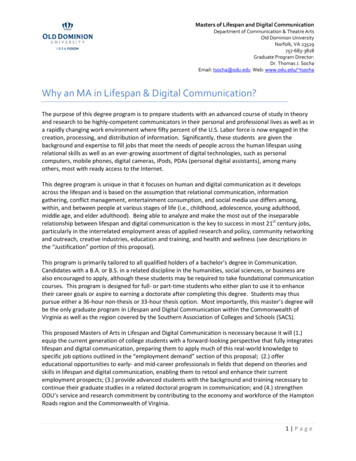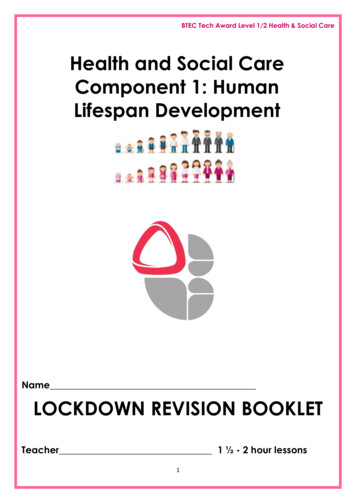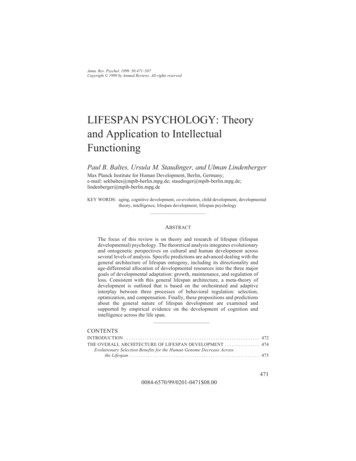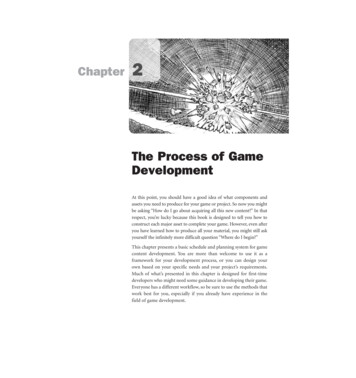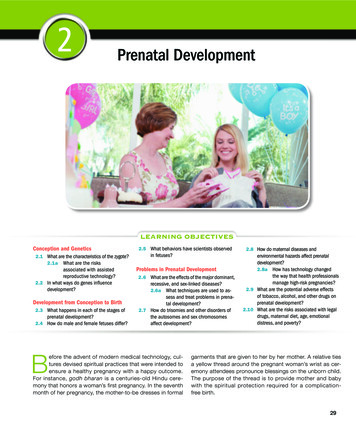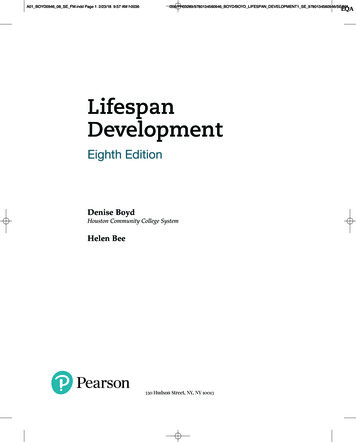
Transcription
A01 BOYD0946 08 SE FM.indd Page 1 2/23/18 9:57 AM f-0036/206/PH03289/9780134560946 BOYD/BOYD LIFESPAN DEVELOPMENT1 SE 9780134560946/SE/MA .LifespanDevelopmentEighth EditionDenise BoydHouston Community College SystemHelen Bee330 Hudson Street, NY, NY 10013
A01 BOYD0946 08 SE FM.indd Page 2 2/22/18 9:15 PM f-0039/206/PH03289/9780134560946 BOYD/BOYD LIFESPAN DEVELOPMENT1 SE 9780134560946/SE/MA .Portfolio Manager: Priya ChristopherPortfolio Manager Assistant: Anna AustinProduct Marketer: Jessica QuazzaContent Developer: Elisa RogersContent Development Manager: Gabrielle WhiteArt/Designer: iEnergizer/Aptara , Ltd.Digital Studio Course Producer: Elissa Senra SargentFull-Service Project Manager: iEnergizer/Aptara , Ltd.Compositor: iEnergizer/Aptara , Ltd.Printer/Binder: LSC Communications, Inc.Cover Printer: PhoenixCover Design: Lumina Datamatics, Inc.Cover Art: Pentagram/Noma BarAcknowledgements of third party content appear on pages 522–525, which constitute an extension of thiscopyright page.Copyright 2019, 2015, 2012 by Pearson Education, Inc. or its affiliates. All Rights Reserved. Printed in theUnited States of America. This publication is protected by copyright, and permission should be obtained fromthe publisher prior to any prohibited reproduction, storage in a retrieval system, or transmission in any form orby any means, electronic, mechanical, photocopying, recording, or otherwise. For information regarding permissions, request forms and the appropriate contacts within the Pearson Education Global Rights & Permissionsdepartment, please visit www.pearsoned.com/permissions/.PEARSON, ALWAYS LEARNING, and REVEL are exclusive trademarks owned by Pearson Education, Inc. orits affiliates, in the U.S., and/or other countries.Unless otherwise indicated herein, any third-party trademarks that may appear in this work are the property oftheir respective owners and any references to third-party trademarks, logos or other trade dress are for demonstrative or descriptive purposes only. Such references are not intended to imply any sponsorship, endorsement,authorization, or promotion of Pearson’s products by the owners of such marks, or any relationship between theowner and Pearson Education, Inc. or its affiliates, authors, licensees or distributors.Library of Congress Cataloging-in-Publication DataNames: Boyd, Denise Roberts, author. Bee, Helen L., 1939- author.Title: Lifespan development / Denise Boyd, Houston Community College System,Helen Bee.Description: Eighth Edition. Boston : Pearson, [2019] Includesbibliographical references and index.Identifiers: LCCN 2017038982 ISBN 9780134560946 (Student Edition) ISBN0134560949 (Student Edition)Subjects: LCSH: Developmental psychology.Classification: LCC BF713 .B69 2019 DDC 155--dc23 LC record available athttps://lccn.loc.gov/201703898210 9 8 7 6 5 4 3 2 1Access Code CardISBN-10:0-13-457761-2ISBN-13: 978-0-13-457761-6Books à la CarteISBN-10:0-13-456094-9ISBN-13: 978-0-13-456094-6Student Rental EditionISBN-10:0-13-516419-2ISBN-13: 978-0-13-516419-8Instructor Review CopyISBN-10:0-13-455030-7ISBN-13: 978-0-13-455030-5
A01 BOYD0946 08 SE FM.indd Page 3 2/19/18 12:20 PM f-0036/206/PH03289/9780134560946 BOYD/BOYD LIFESPAN DEVELOPMENT1 SE 9780134560946/SE/MA .Brief Contents1Basic Concepts and Methods 111Physical and Cognitive Development inAdolescence 2232Theories of Development 2012Social and Personality Development inAdolescence 2503Prenatal Development and Birth 424Physical, Sensory, and PerceptualDevelopment in Infancy 6713Physical and Cognitive Development inEarly Adulthood 2725Cognitive Development in Infancy 87146Social and Personality Development inInfancy 107Social and Personality Development inEarly Adulthood 297157Physical and Cognitive Development inEarly Childhood 127Physical and Cognitive Development inMiddle Adulthood 319168Social and Personality Development inEarly Childhood 150Social and Personality Development inMiddle Adulthood 339179Physical and Cognitive Development inMiddle Childhood 179Physical and Cognitive Development inLate Adulthood 3561810Social and Personality Development inMiddle Childhood 203Social and Personality Development inLate Adulthood 37919Death, Dying, and Bereavement 399iii
A01 BOYD0946 08 SE FM.indd Page 4 2/19/18 12:20 PM f-0036/206/PH03289/9780134560946 BOYD/BOYD LIFESPAN DEVELOPMENT1 SE 9780134560946/SE/MA .ContentsPreface xAcknowledgments xivAbout the Author xv11.11.21.31.4Basic Concepts and Methods 1234Key Issues in the Study of Human Development 1.2.1 Nature Versus Nurture 1.2.2 Continuity Versus Discontinuity 1.2.3 Three Kinds of Change 5556 Research Report: An Example of a Cohort Effect:Children and Adolescents in the Great Depression 81.2.48Contexts of Development 22.12.22.32.4iv99 No Easy Answers: It Depends . . . 101.3.21.3.3Descriptive Methods The Experimental Method 1012Research Designs 1.4.1 Cross-Sectional, Longitudinal, andSequential Designs 1.4.2 Cross-Cultural Research 1.4.3 Research Ethics 14Summary: Basic Concepts and Methods 14161719Theories of Development 20Psychoanalytic Theories 2.1.1 Freud’s Psychosexual Theory 2021 No Easy Answers The Repressed Memory Controversy 212.1.22.1.32226Erikson’s Psychosocial Theory Evaluation of Psychoanalytic Theories 2.51An Introduction to Human Development 1.1.1 Philosophical and Scientific Roots 1.1.2 The Lifespan Perspective 1.1.3 The Domains and Periods of Development Research Methods 1.3.1 The Goals of Developmental Science 2.4.22.4.3Learning Theories 2.2.1 Classical Conditioning 2.2.2 Skinner’s Operant Conditioning 2.2.3 Bandura’s Social-Cognitive Theory 2.2.4 Evaluation of Learning Theories 2627282930Cognitive Theories 2.3.1 Piaget’s Cognitive-Developmental Theory 2.3.2 Vygotsky’s Sociocultural Theory 2.3.3 Information-Processing Theory 2.3.4 Evaluation of Cognitive Theories 3031333334Biological and Ecological Theories 2.4.1 Behavior Genetics 3535Ecological Theories Bronfenbrenner’s Bioecological Theory Comparing Theories 2.5.1 Assumptions About Development 2.5.2 Usefulness 2.5.3 Eclecticism Summary: Theories of Development 33.1Prenatal Development and Birth Conception and Genetics 3.1.1 The Process of Conception 35373839394041424242 Research Report: Twins in Genetic Research 443.1.244How Genes Influence Development 3.2Genetic and Chromosomal Disorders 3.2.1 Genetic Disorders 3.2.2 Chromosomal Errors 4646483.3Pregnancy and Prenatal Development 3.3.1 The Mother’s Experience 3.3.2 Prenatal Development 3.3.3 Sex Differences 3.3.4 Prenatal Behavior 49495052533.4Substance-Related Problems in PrenatalDevelopment 3.4.1 How Teratogens Influence Development 3.4.2 Drugs, Tobacco, and Alcohol 5354553.53.6Maternal Influences and Fetal Health 3.5.1 Maternal Diseases 3.5.2 Other Maternal Influences on PrenatalDevelopment 3.5.3 Fetal Assessment and Treatment 5759Birth and the Neonate 3.6.1 Birth Choices 3.6.2 The Physical Process of Birth 3.6.3 Assessing the Neonate 3.6.4 Low Birth Weight and Preterm Birth 6061626464 No Easy Answers: When Do Preterm InfantsCatch Up? Summary: Prenatal Development and Birth 44.1Physical, Sensory, and PerceptualDevelopment in Infancy Neurological and Behavioral Changes in Infancy 4.1.1 The Infant’s Brain and Nervous System 56566565676768 No Easy Answers: TV for Tots: How MuchIs Too Much? 694.1.269Reflexes and Behavioral States
A01 BOYD0946 08 SE FM.indd Page 5 2/20/18 10:28 AM f-0036/206/PH03289/9780134560946 BOYD/BOYD LIFESPAN DEVELOPMENT1 SE 9780134560946/SE/MA .Contents4.24.34.44.54.6Growth, Motor Skills, and DevelopingBody Systems 4.2.1 Growth and Motor Skills 4.2.2 Explaining Motor Skills Development 4.2.3 Developing Body Systems 71717272Infant Health and Wellness 4.3.1 Nutrition 4.3.2 Malnutrition 4.3.3 Health Care and Immunizations 73737475Infant Mortality 4.4.1 Sudden Infant Death Syndrome 4.4.2 Group Differences in Infant Mortality 757577Sensory Skills 4.5.1 Vision 4.5.2 Hearing and Other Senses 797980Perceptual Skills 4.6.1 Studying Perceptual Development 4.6.2 Looking 808181 Research Report: Langlois’s Studies of Babies’Preferences for Attractive Faces 834.6.34.6.44.6.5Listening 83Combining Information from Several Senses 84Explaining Perceptual Development 85Summary: Physical, Sensory, and PerceptualDevelopment in Infancy 55.15.25.35.466.187Cognitive Changes and Intelligence in Infancy 5.1.1 Piaget’s Sensorimotor Stage 5.1.2 Challenges to Piaget’s Explanation of InfantCognitive Development 5.1.3 Alternative Approaches 5.1.4 Measuring Intelligence in Infancy 8788919294Learning, Categorizing, and Remembering 5.2.1 Conditioning and Modeling 5.2.2 Schematic Learning 5.2.3 Memory 94949596Theoretical Perspectives and Influenceson Language Development 5.3.1 Theoretical Perspectives 5.3.2 Influences on Language Development 979798107108108 No Easy Answers: Adoption and Development 1096.2Attachment 6.2.1 The Parents’ Attachment to the Infant 6.2.2 The Infant’s Attachment to the Parents 1091101116.3Factors Influencing Attachment 6.3.1 Variations in Attachment Quality 6.3.2 Caregiver Characteristics and Attachment 6.3.3 Long-Term Consequences of AttachmentQuality 6.3.4 Cross-Cultural Research on Attachment 1121121141151166.4Personality, Temperament, and Self-Concept 6.4.1 Dimensions of Temperament 6.4.2 Origins and Stability of Temperament 6.4.3 Self-Concept in Infancy 1171171181206.5Effects of Nonparental Care 6.5.1 Difficulties in Studying Nonparental Care 6.5.2 Effects on Physical and CognitiveDevelopment 6.5.3 Effects on Social Development 6.5.4 Interpreting Research on Nonparental Care 122122Summary: Social and Personality Developmentin Infancy 77.15.4.25.4.35.4.45.4.5The First Words The First Sentences Individual Differences in LanguageDevelopment Language Development Across Cultures No Easy Answers: One Language or Two? Summary: Cognitive Development in Infancy 102105106125Physical and Cognitive Developmentin Early Childhood 1271281297.2Health and Wellness in Early Childhood 7.2.1 Young Children’s Health-Care Needs 7.2.2 Abuse and Neglect 1311311327.3Piaget’s Preoperational Stage of CognitiveDevelopment 134 Research Report: Children’s Play andCognitive Development 1347.3.17.3.27.4103104104104123124124Physical Changes in Early Childhood 7.1.1 Growth and Motor Development in EarlyChildhood 7.1.2 The Brain and Nervous System Language Development Milestones 1015.4.1 Early Milestones of Language Development 101 Research Report: Early Gestural Language inthe Children of Deaf Parents Social and Personality Developmentin Infancy 107Theories of Social and Personality Development 6.1.1 Psychoanalytic Perspectives 6.1.2 Ethological Perspectives 85Cognitive Development in Infancy v7.5127Piaget’s View of Early Childhood Thinking 135Challenges to Piaget’s View 137Other Cognitive Changes in Early Childhood 7.4.1 Theories of Mind 7.4.2 Alternative Theories of Early ChildhoodThinking 138138139Changes in Language 7.5.1 Fast-Mapping 7.5.2 The Grammar Explosion 7.5.3 Phonological Awareness 141141142142
A01 BOYD0946 08 SE FM.indd Page 6 2/19/18 12:20 PM f-0036/206/PH03289/9780134560946 BOYD/BOYD LIFESPAN DEVELOPMENT1 SE 9780134560946/SE/MA .vi Contents7.6Individual Differences in Intelligence 7.6.1 Measuring Intelligence 7.6.2 Origins of Individual Differencesin Intelligence 7.6.3 Group Differences inIntelligence-Test Scores 147 No Easy Answers: To Test or Not to Test? 148Summary: Physical and Cognitive Developmentin Early Childhood 88.1145Social and Personality Developmentin Early Childhood 150150151151 Research Report: Racism in the PreschoolClassroom 1528.2Personality and Self-Concept 8.2.1 From Temperament to Personality 8.2.2 Self-Concept in Early Childhood 1541541548.3Gender Development 8.3.1 Explaining Gender Development 8.3.2 Sex-Role Knowledge 8.3.3 Sex-Typed Behavior 157157159159Family Relationships and Parenting 8.4.1 Attachment in Early Childhood 8.4.2 Parenting Styles 8.4.3 Ethnicity, Socioeconomic Status,and Parenting Styles 1621621638.58.6167Family Structure 1688.5.1 Family Structure and Early Childhood 1698.5.2 Divorce 1718.5.3 Understanding the Effects of Family Structureand Divorce 172Peer Relationships in Early Childhood 8.6.1 Relating to Peers Through Play 8.6.2 Aggression 8.6.3 Prosocial Behavior and Friendships 173173174176Summary: Social and Personality Developmentin Early Childhood 17799.19.2Physical and Cognitive Developmentin Middle Childhood 179Physical Changes in Middle Childhood 9.1.1 Growth and Motor Development in MiddleChildhood 9.1.2 The Brain and Nervous System 9.1.3 Health and Wellness in Middle Childhood Cognitive Changes in Middle Childhood 9.2.1 Language Development inMiddle Childhood 9.2.2 Piaget’s Concrete Operational Stage 179180180181184184184Direct Tests of Piaget’s View 186Advances in Information-Processing Skills 1879.3Schooling in Middle Childhood 9.3.1 Literacy 9.3.2 Second-Language Learners 1891901919.4Achievement and Intelligence 9.4.1 Theories of Multiple Intelligences 9.4.2 Achievement Tests 191192192 No Easy Answers: IQ Testing in Schools 1929.4.3Group Differences in Achievement 193Children With Special Needs 9.5.1 Learning Disabilities 9.5.2 Attention-Deficit/Hyperactivity Disorder 197197199148Theories of Social and PersonalityDevelopment 8.1.1 Psychoanalytic Perspectives 8.1.2 Social-Cognitive Perspectives 8.49.2.39.2.41431439.5Summary: Physical and Cognitive Developmentin Middle Childhood 10201Social and Personality Developmentin Middle Childhood 20310.1 Theories of Social and Personality Development inMiddle Childhood 20410.1.1 Psychoanalytic Perspectives 20410.1.2 The Trait and Social-Cognitive Perspectives 20410.2 Self-Concept in Middle Childhood 10.2.1 The Psychological Self 10.2.2 The Valued Self 20620620710.3 Advances in Social Cognition 10.3.1 The Child as Psychologist 10.3.2 Moral Reasoning 20820820810.4 Family and Peer Relationships in MiddleChildhood 10.4.1 Relationships With Parents 10.4.2 Friendships in Middle Childhood 10.4.3 Gender Self-Segregation 21121121221210.5 Aggression and Social Status 10.5.1 Patterns of Aggression 214214 No Easy Answers: Bullies and Victims 21510.5.2 Social Status 21610.6 Influences Beyond Family and Peers 10.6.1 Poverty 10.6.2 Media Influences 217217218Summary: Social and Personality Developmentin Middle Childhood 22111Physical and Cognitive Developmentin Adolescence 22311.1 Physical Changes in Adolescence 11.1.1 Brain Developmentand Physical Growth 11.1.2 Milestones of Puberty 11.1.3 The Timing of Puberty 22322422522711.2 Adolescent Sexuality 11.2.1 Sexual Behavior 228228
A01 BOYD0946 08 SE FM.indd Page 7 2/20/18 10:29 AM f-0036/206/PH03289/9780134560946 BOYD/BOYD LIFESPAN DEVELOPMENT1 SE 9780134560946/SE/MA .Contents vii11.2.2 Adolescent Pregnancy 11.2.3 Sexual Minority Youth 23023213.1.2 The Brain and Nervous System in EarlyAdulthood 11.3 Adolescent Health 11.3.1 Sensation Seeking 11.3.2 Drugs, Alcohol, and Tobacco 11.3.3 Eating Disorders 11.3.4 Depression and Suicide 234234234237238 Research Report: Gender Differences in the Brain 27513.1.3 Other Body Systems 27511.4 Changes in Thinking and Memory 240 Research Report: Formal Operational Thinkingand Everyday Problem Solving 24011.4.1 Piaget’s Formal Operational Stage 11.4.2 Direct Tests of Piaget’s View 11.4.3 Advances in Information Processing 24124224311.5: Adolescent Schooling 11.5.1 Transition to Secondary School 11.5.2 Gender, Ethnicity, and Achievement inScience and Math 11.5.3 Dropping Out of High School 244244246247Summary: Physical and Cognitive Development inAdolescence 24812Social and Personality Developmentin Adolescence 25012.1 Theories of Social and Personality Development inAdolescence 25012.1.1 Psychoanalytic Perspectives 25112.1.2 Marcia’s Theory of Identity Achievement 25112.2 Self-Concept in Adolescence 12.2.1 Self-Understanding 12.2.2 Self-Esteem 12.2.3 Gender Roles 12.2.4 Ethnic Identity 25425425525525712.3 Kohlberg’s Approach to Moral Development 12.3.1 Kohlberg’s Theory of Moral Reasoning 12.3.2 Causes and Consequences of MoralDevelopment 12.3.3 Criticisms of Kohlberg’s Theory 12.3.4 Moral Development andAntisocial Behavior 259259264 No Easy Answers: Moral Development andAdolescent Aggression 26526126312.4 Social Relationships 12.4.1 Relationships With Parents 12.4.2 Friendships in Adolescence 12.4.3 Peer Groups 12.4.4 Romantic Relationships 266266267267268Summary: Social and Personality Developmentin Adolescence 27013Physical and Cognitive Developmentin Early Adulthood 27213.1 Physical Functioning 13.1.1 Primary and Secondary Aging 272273274 No Easy Answers: Assisted ReproductiveTechnology 27713.2 Health and Wellness in Early Adulthood 13.2.1 Health Habits and Personal Factors 13.2.2 Sexually Transmitted Diseases 13.2.3 Intimate Partner Abuse 13.2.4 Mental Health in Early Adulthood 13.2.5 Substance Use and Abuse 27827828128328528813.3 Cognitive Changes in Early Adulthood 13.3.1 Postformal Thought 13.3.2 Intelligence 29029029113.4 Postsecondary Education 13.4.1 Developmental Impact 13.4.2 Gender, Ethnicity, and Disability and theCollege Experience 292293293Summary: Physical and Cognitive Developmentin Early Adulthood 29514Social and Personality Developmentin Early Adulthood 29714.1 Theories of Social and Personality Development 29714.1.1 Erikson’s Stage of Intimacy Versus Isolation 29814.1.2 Levinson’s Life Structures 29814.1.3 Emerging Adulthood 29914.2 Heterosexual Intimate Relationships 14.2.1 Theories of Mate Selection 14.2.2 Marriage 299301302 No Easy Answers: Wedding Stress Management 30314.2.3 Cohabiting Heterosexual Couples 30614.3 Same-Sex Intimate Relationships and Singlehood 14.3.1 Gay and Lesbian Couples 14.3.2 Singlehood 30730730714.4 Parenthood and Other Relationships 14.4.1 Parenthood 14.4.2 Social Networks 30930931014.5 The Role of Worker 14.5.1 Choosing a Career 14.5.2 Career Development 31231231314.6 Work–Life Balance 14.6.1 The Quality of Work–Life Movement 14.6.2 Women’s Work Patterns 315315316Summary: Social and Personality Developmentin Early Adulthood 31715Physical and Cognitive Developmentin Middle Adulthood 31915.1 Reproductive Changes in Middle Adulthood 15.1.1 Male Climacteric 319320
A01 BOYD0946 08 SE FM.indd Page 8 2/19/18 12:20 PM f-0036/206/PH03289/9780134560946 BOYD/BOYD LIFESPAN DEVELOPMENT1 SE 9780134560946/SE/MA .viii Contents15.1.2 Menopause 320 No Easy Answers: The Pros and Consof Hormone Therapy 32115.1.3 Sexual Activity 32215.2 Other Physical Changes in Middle Adulthood 15.2.1 The Brain and Nervous System in MiddleAdulthood 15.2.2 The Skeletal System 15.2.3 Vision and Hearing 32332332432515.3 Health and Wellness in Middle Adulthood 15.3.1 Cardiovascular Disease Risks 15.3.2 Cancer 15.3.3 Alcoholism 32532632832815.4 Health Disparities 32915.4.1 Gender and Health 33015.4.2 Socioeconomic Class, Ethnicity, and Health 33015.5 Cognitive Functioning in Middle Adulthood 15.5.1 Models of Physical and Cognitive Aging 15.5.2 Health and Cognitive Functioning 15.5.3 Changes in Memory and Cognition 15.5.4 Creativity 332332333334336Summary: Physical and Cognitive Developmentin Middle Adulthood 33716Social and Personality Developmentin Middle Adulthood 33916.1 Theories of Social and Personality Developmentin Middle Adulthood 16.1.1 Erikson’s Generativity-Versus-StagnationStage 16.1.2 Midlife Crisis—Fact or Fiction? 33934016.2 Changes in Relationships and Personality 16.2.1 Partnerships 16.2.2 The Role of Caregiver 343343344339 No Easy Answers: Who Cares for Aging Parents? 34616.2.3 Grandparenting 16.2.4 Friends in Middle Adulthood 16.2.5 Continuity and Change in Personality 34734834817.2 Physical Changes in Late Adulthood 17.2.1 The Brain and Nervous System in LateAdulthood 17.2.2 The Senses 36136136217.3 Causes and Effects of Biological Aging 17.3.1 Theories of Biological Aging 17.3.2 Behavioral Effects of Biological Aging 36336336517.4 Mental Health in Late Adulthood 36717.4.1 Alzheimer’s Disease and Other Dementias 367 Research Report: Mild Cognitive Impairment (MCI),Age-Associated Cognitive Decline (AACD), andAlzheimer’s Disease 36817.4.2 Depression 37017.5 Cognitive Changes in Late Adulthood 17.5.1 Memory in Late Adulthood 17.5.2 Wisdom and Creativity Summary: Physical and Cognitive Developmentin Late Adulthood 18373373376377Social and Personality Developmentin Late Adulthood 37918.1 Theories of Social and Personality Developmentin Late Adulthood 18.1.1 Erikson’s Stage of Ego IntegrityVersus Despair 18.1.2 Other Theories of Late-Life PsychosocialFunctioning 38018.2 Individual Differences 18.2.1 The Successful Aging Paradigm 18.2.2 Religious Coping 38138238318.3 Changes in Living Arrangements AssociatedWith Aging 18.3.1 Aging in Place 385385379380 Research Report: Filial Piety 38618.3.2 Residential Options for Older Adults 387 No Easy Answers: Deciding on Nursing Home Care 38818.4 Social Relationships in Late Adulthood 18.4.1 Partnerships in Late Adulthood 18.4.2 Family Relationships and Friendships 18.4.3 Gender and Ethnic Differences in SocialNetworks 38838839039116.3 Midlife Career Issues 16.3.1 Work Satisfaction 16.3.2 Job Performance 16.3.3 Unemployment and Career Transitions 16.3.4 Preparing for Retirement 349350351351353Summary: Social and Personality Developmentin Middle Adulthood 18.5 Career Issues in Late Life 18.5.1 Timing of and Reasons for Retirement 18.5.2 Effects of Retirement 392392394354Summary: Social and Personality Developmentin Late Adulthood 39717Physical and Cognitive Developmentin Late Adulthood 35617.1 Variability in Late Adulthood 17.1.1 Life Expectancy and Longevity 356356 No Easy Answers: The GlobalDemographic Crisis 35717.1.2 Health 35819Death, Dying, and Bereavement 39919.1 The Experience of Death 19.1.1 Death Itself 19.1.2 Where Death Occurs 39939940019.2 The Meaning of Death Across the Lifespan 19.2.1 Children’s and Adolescents’Understanding of Death 401401
A01 BOYD0946 08 SE FM.indd Page 9 2/21/18 7:56 AM f-0036/206/PH03289/9780134560946 BOYD/BOYD LIFESPAN DEVELOPMENT1 SE 9780134560946/SE/MA .Contents ix19.2.2 The Meaning of Death for Adults 40319.3 Fear of Death and Preparation for Death 19.3.1 Fear of Death 19.3.2 Preparation for Death 404404405 No Easy Answers: Saying Good-Bye 40619.4 The Process of Dying 19.4.1 Kübler-Ross’s Stages of Dying 19.4.2 Criticisms and Alternative Views 19.4.3 Responses to Impending Death 40640640740919.5 Theoretical Perspectives on Grieving 19.5.1 Freud’s Psychoanalytic Theory 19.5.2 Bowlby’s Attachment Theory 19.5.3 Alternative Perspectives 41041041141219.6 The Experience of Grieving 19.6.1 Psychosocial Functions ofDeath Rituals 19.6.2 The Process of Grieving 19.6.3 Widowhood Research Report: Ethnicity andthe Widowhood Effect 413413413417417Summary: Death, Dying, and Bereavement 419Glossary References Credits Name Index Subject Index 420439522526551
A01 BOYD0946 08 SE FM.indd Page 10 2/22/18 9:32 PM f-0039/206/PH03289/9780134560946 BOYD/BOYD LIFESPAN DEVELOPMENT1 SE 9780134560946/SE/MA .PrefaceHaving taught human development for many years, Iknow that teaching a course in lifespan development isone of the most difficult assignments an instructor canface. You must deal with the challenge of getting throughall the necessary descriptive material in a single semester.At the same time, you have to cover theories of development, some of which are among the most complex andimportant theories in the behavioral sciences. In preparingthis eighth edition of Lifespan Development, I hoped to support lifespan development instructors by producing a textthat thoroughly addresses the basic facts of development,makes the more abstract material about theories understandable to students, and motivates them to read the textby presenting information in a way that is both engagingand relevant to real-world applications of developmentalscience.Content Organizationand HighlightsWe begin our exploration of lifespan development inChapter 1 by introducing students to the science of humandevelopment, its history, and its methods. In Chapter 2, weturn to theories of development. We cover both classic andcontemporary theories as well as the criteria that developmentalists use to compare them. Chapter 3 deals with prenatal development and the beginning days of life.Perceptual development in infancy is the subject ofChapter 4. We explore infants’ remarkable sensory abilitiesand how they interpret what they see, hear, smell, taste,and touch. We discuss infants’ cognitive development inChapter 5. The chapter addresses Piaget’s research and thetheoretical concepts he proposed to explain his findings.Learning, memory, the beginnings of language, and a discussion of individual differences in intelligence follow. InChapter 6, we move on to infants’ social and personalitydevelopment, including the important topics of temperament and attachment.Early childhood (ages 2 to 6) physical and cognitivedevelopment are the subjects of Chapter 7. We outline thecritical changes in children’s bodies and minds that enablethem to become less dependent on adults. In Chapter 8, wefocus on the development of important aspects of the self,such as personality and gender role development. Socialrelationships are also addressed in this chapter.We discuss cognitive development among school-agechildren (ages 6 to 12) in Chapter 9. In explaining cognitivexdevelopment, we emphasize the interactive influence ofinternal factors such as intelligence and external factorssuch as formal education. Themes of personality changeand the development of stable peer relationships are thetopics of Chapter 10.Moving on to the teen years in Chapter 11, we presentadolescence as a period of risks and opportunities thatteens navigate with the help of newly developed, yet powerful, cognitive tools. Peer relationships occupy an important place in Chapter 12. Nevertheless, we point out thatrelationships with parents continue to be important toteens.In early adulthood, about ages 20 to 40, developmentalpathways begin to diverge significantly. As we show inChapter 13, many adults reach their physical peak duringthese years. Others establish habits that lead to poor healthlater in life. Young adults’ educational choices are anothersource of divergence. In Chapter 14, we discuss the obstaclesand milestones that young adults confront as they becomeestablished in adult relationships, roles, and careers.The importance of the behavioral choices of earlyadulthood comes to light in middle adulthood (ages 40 to65), as we discuss in Chapter 15. We point out that manyof the challenges of this period arise from physical andcognitive changes. Changing social roles is the theme ofChapter 16.Chapters 17 and 18 deal with later adulthood, age 65and beyond. We discuss inevitable physical declines andthe strategies that older adults use to cope with them.Social roles continue to be redefined as adults age. In manycases, social networks become more important than familynetworks. Finally, in Chapter 19, we address the topics ofdeath, dying, and bereavement.Why Do You Need ThisNew Edition?Each revision of Lifespan Development provides us with anopportunity to critically examine and improve all aspectsof the text’s organization and pedagogy. Here are some ofthe improvements we’ve made to the eighth edition:Assessment-Driven LearningObjectivesCollege faculty and administrators are seeking ways tointegrate opportunities for assessment and accountability
A01 BOYD0946 08 SE FM.indd Page 11 2/22/18 9:32 PM f-0039/206/PH03289/9780134560946 BOYD/BOYD LIFESPAN DEVELOPMENT1 SE 9780134560946/SE/MA .Prefaceinto the instructional materials that they require studentsto use. In response to this need, we have revised everyinstructional objective in Lifespan Development to increasethe text’s focus on assessment. Our goal is to provide readers with the direction they need to extract key informationfrom the text. Importantly, too, we want to be sure thatevery objective helps instructors choose test items andbuild assignments that answer the questions, “Arestudents learning what they should from a course inhuman development, and are they capable of applyingwhat they are learning to practical questions about humandevelopment?”Updated CoverageThis edition includes new information on these topics: Prenatal exposure to maternal stress and children’ssocial reasoning skills (Chapter 3) Interactions between parenting and temperament(Chapter 6) Abuse in early childhood as a predictor of adolescentsubstance abuse (Chapter 7) Preschool participation and adolescent health outcomes (Chapter 7) Interactions between socioeconomic status and cognitive development (Chapter 7) Maternal influence on ethnic identity development(Chapter 12) Intimate partner abuse and self-rated quality of life(Chapter 13) Self-esteem, depression, and intimate partnerships(Chapter 14) Selection, optimization, and compensation in everyday life (Chapter 15) Unemployment and depression (Chapter 16) Difficult life experiences and the development ofwisdom (Chapter 17) Effects of verbalization on memory function (Chapter 17) Function of reminiscence among nursing home residents (Chapter 18) Social support and caregiver stress (Chapter 19)In-Chapter VideosVideo topics range from discussions of contemporaryresearch to personal stories of individuals’ struggles withand triumphs over the challenges associated with eachphase of the lifespan. Here is a list of video titles. The Experimental Method Research Ethics Nonverbal communication skills and theory of minddevelopment (Chapter 7) Freud’s Theory of Personality Parenting styles in same-sex-couple-headed families(Chap
1.1 An Introduction to Human Development 1 1.1.1 Philosophical and Scientific Roots 2 1.1.2 The Lifespan Perspective 3 1.1.3 The Domains and Periods of Development 4 1.2 Key Issues in the Study of Human Development 5 1.2.1 Nature Ver
